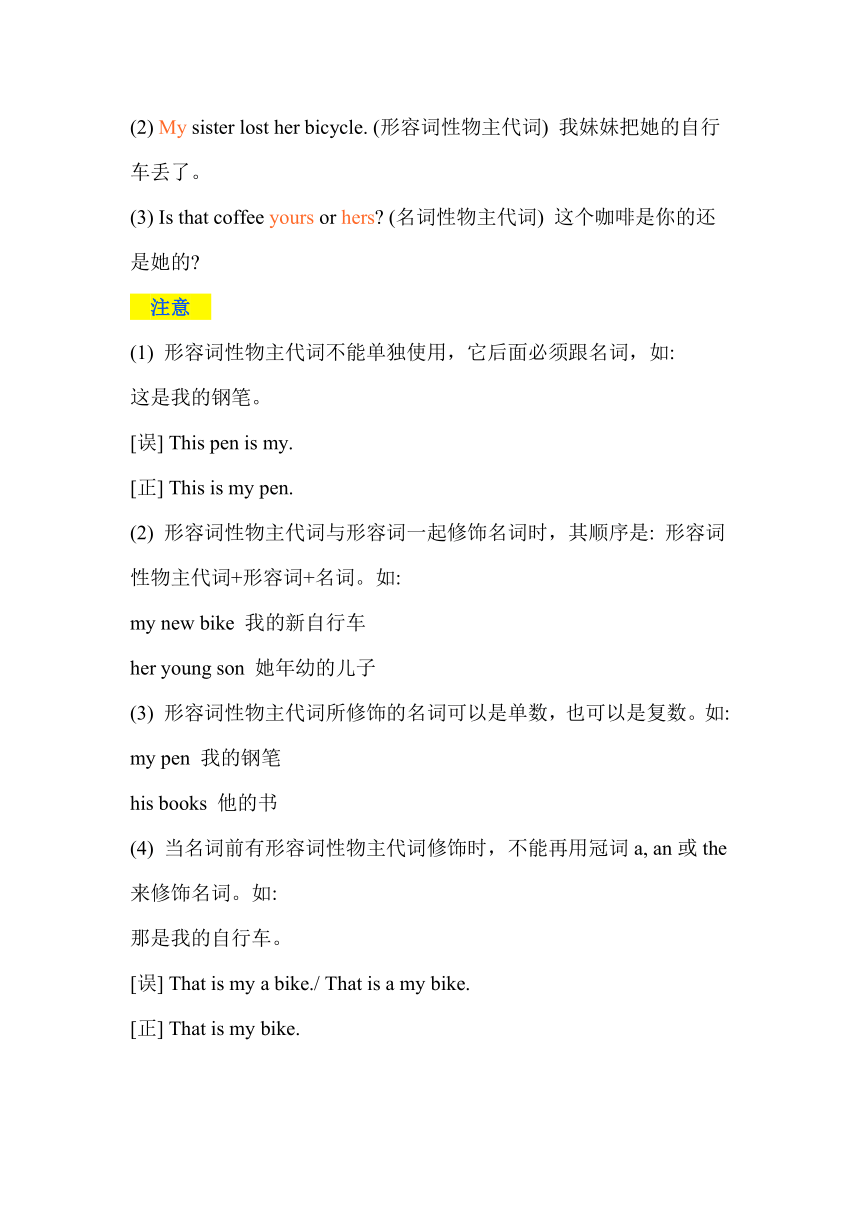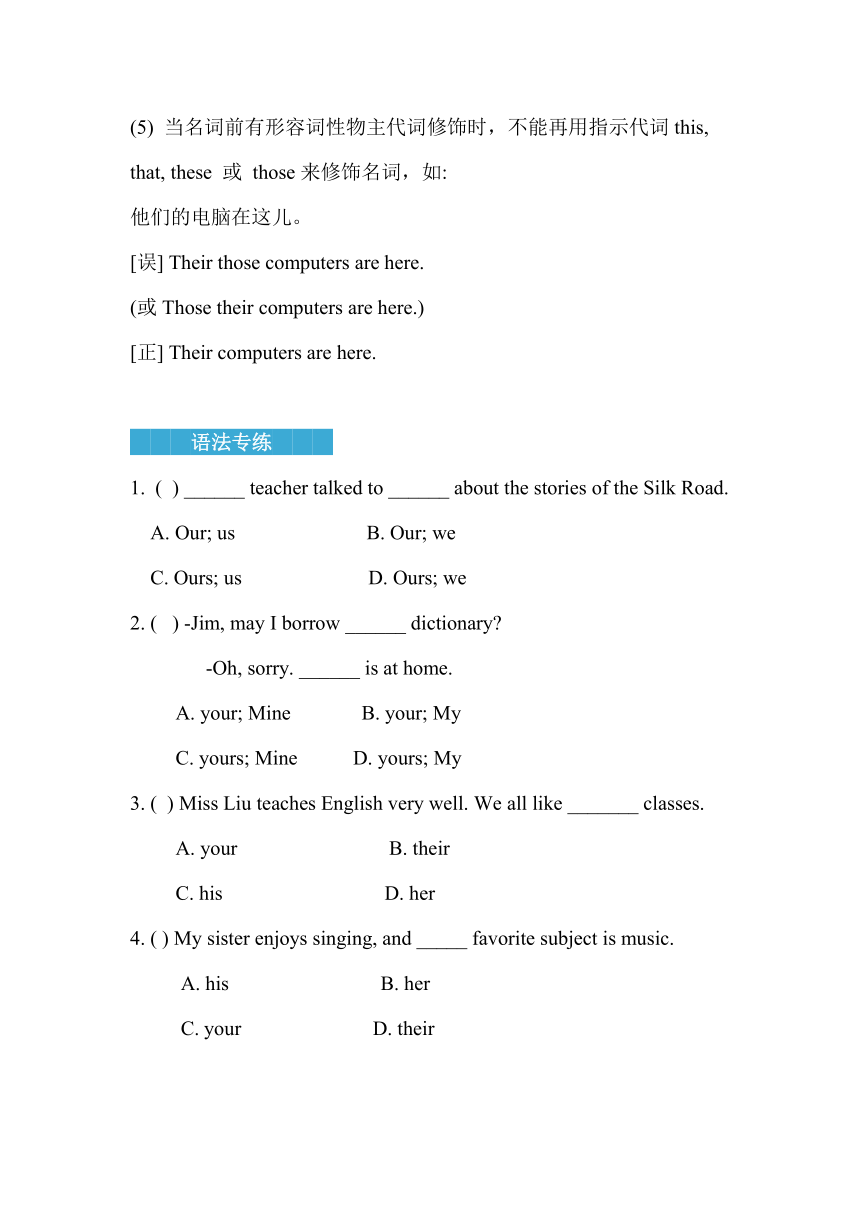2024仁爱科普版英语七上Unit 2 Meet My Family! 语法专题讲解和专练(含答案)
文档属性
| 名称 | 2024仁爱科普版英语七上Unit 2 Meet My Family! 语法专题讲解和专练(含答案) |  | |
| 格式 | docx | ||
| 文件大小 | 304.2KB | ||
| 资源类型 | 教案 | ||
| 版本资源 | 仁爱科普版 | ||
| 科目 | 英语 | ||
| 更新时间 | 2024-10-05 21:01:39 | ||
图片预览




文档简介
2024仁爱科普版英语七上Unit 2 语法专题讲解和专练(含答案)
语法讲解
物主代词 (Possessive Pronouns)
物主代词是用来表示所有关系的代词。物主代词分形容词性物主代词和名词性物主代词,也有人称和数的变化。物主代词的形式与分类如下表:
用法:
形容词性物主代词在句中只用作定语,相当于一个形容词,名词性物主代词相当于一个名词。如:
(1) Here is my dog. Its name is Tom. (形容词性物主代词) 这是我的狗,它叫汤姆。
(2) My sister lost her bicycle. (形容词性物主代词) 我妹妹把她的自行车丢了。
(3) Is that coffee yours or hers (名词性物主代词) 这个咖啡是你的还是她的
注意
(1) 形容词性物主代词不能单独使用,它后面必须跟名词,如:
这是我的钢笔。
[误] This pen is my.
[正] This is my pen.
(2) 形容词性物主代词与形容词一起修饰名词时,其顺序是: 形容词性物主代词+形容词+名词。如:
my new bike 我的新自行车
her young son 她年幼的儿子
(3) 形容词性物主代词所修饰的名词可以是单数,也可以是复数。如:
my pen 我的钢笔
his books 他的书
(4) 当名词前有形容词性物主代词修饰时,不能再用冠词a, an或the来修饰名词。如:
那是我的自行车。
[误] That is my a bike./ That is a my bike.
[正] That is my bike.
(5) 当名词前有形容词性物主代词修饰时,不能再用指示代词this, that, these 或 those来修饰名词,如:
他们的电脑在这儿。
[误] Their those computers are here.
(或Those their computers are here.)
[正] Their computers are here.
语法专练
( ) ______ teacher talked to ______ about the stories of the Silk Road.
A. Our; us B. Our; we
C. Ours; us D. Ours; we
2. ( ) -Jim, may I borrow ______ dictionary
-Oh, sorry. ______ is at home.
A. your; Mine B. your; My
C. yours; Mine D. yours; My
3. ( ) Miss Liu teaches English very well. We all like _______ classes.
A. your B. their
C. his D. her
4. ( ) My sister enjoys singing, and _____ favorite subject is music.
A. his B. her
C. your D. their
5. ( ) The girl with a pair of glasses is Nancy. _____ father is my English teacher.
A. His B. Her
C. Your D. Hers
一般现在时 (The simple present tense ) II
动词do的一般现在时
英语中动词“do”的含义是“做、干、办(某事)”时是行为动词。
1.一般现在时中行为动词do有两种形式,即动词原形do和第三人称单数形式does。其否定句、疑问句的构成要借助于助动词do和does(无实际意义)。其肯定形式、否定形式如下表:
2.动词do疑问形式及简略答语如下表:
说明: does not = doesn't do not = don't
行为动词的第三人称单数形式变化规则如下表:
注意 : have的第三人称单数形式是has。
语法专练
用括号内动词的正确形式填空。
1. Jenny ________ (work) in an office. Her parents ________ (work) in a hospital.
2. _______ your sister _______ (know) English
3. Where _______ you _______ (have) lunch everyday
4. ________ she ________ (do) the housework everyday
5. Jenny and Danny usually ________ (play) games in the afternoon.
阅读能力提升
◆ 阅读策略点拨
略读或跳读( Skimming )
阅读时,如果只关注文章的大意和关键情节,可以采用略读或跳读的方法,而不需要逐字逐句地通读文章。
略读是指在阅读的过程中,读者只要抓住关键性语句,弄清主要观点,了解主要事实的一种阅读方法。通常可以通过阅读文章的标题、开头、结尾等达到阅读目的;跳读,就是在略读过程中,跳过那些与主题关系不密切或与阅读任务无关的细节,以最快的速度,找到自己需要的细节信息。略读和跳读是快速获取文章的重要信息、了解文章大意的重要手段。
以教材第25页Activity 1为例: 从第一语段和第二语段首句,我们可以获取“这个世界上既有大的家庭, 也有小的家庭”这个关键信息。其他的内容和文章末尾的阅读任务无关,可以忽略。
同样,采用跳读或略读的方法,我们可以很快地在Activity 2的短文中画出主题句“All families are different." 以及关键词“big'’,和small。
◆ 能力提升实践
My name is Jack. I am an English man. I have a big family. This is my family photo.
This is my wife(妻子),Allen. She is a teacher. We have two children, Tom and Linda. They are students. They are my father, Jeff, and my mother, Grace. They are old, but they are in good health(健康). The tall man is my brother, Bill. He is a worker. The young girl is my sister, Nancy. She is a doctor.
In the photo, we enjoy our family time. Everyone looks happy. I have a big and happy family.
选出文章的主题句: ( )
A. I am an Englishman.
B. This is my family photo.
C. I have a happy and big family.
答案: C
语法专练
1. A 2. A 3. D 4. B 5. B
语法专练
1. works; work
2. Does; know
3. do; have
4. Does; do
5. play
Unit 2 基础巩固
一、
1. (1) teaches (2) factory
(3) only (4) set
(5) pretty
2. (1) policewoman
(2) rides (3) sets
(4) film (5) Its
二、1.A 2.B 3.D 4.D 5.C
6.B 7.C 8.C 9.B 10.B
三、
1. works as
2. in white
3. do something
4. Most of
5. only child
四、1.E 2.G 3.B 4.A 5.F
五、1.B 2.A 3.C 4.C 5.A
6.C 7.B 8.A 9.A 10. A
六、
1. a 2. drives
3. every/ each 4. nurse
5. after 6. lot
7. Saturdays 8. help
9. brother 10. together
七、
I'm very happy to introduce my family to you. I have a big family. Seven people are in my family. They are my grandparents, my parents, my sister, my brother and I. My father is a cook. He works in a restaurant. My mother is a teacher. She teaches Chinese in a high school. I have a brother and a sister, and we are students. My grandparents live with us. They are very nice to us. I love my family very much.
语法讲解
物主代词 (Possessive Pronouns)
物主代词是用来表示所有关系的代词。物主代词分形容词性物主代词和名词性物主代词,也有人称和数的变化。物主代词的形式与分类如下表:
用法:
形容词性物主代词在句中只用作定语,相当于一个形容词,名词性物主代词相当于一个名词。如:
(1) Here is my dog. Its name is Tom. (形容词性物主代词) 这是我的狗,它叫汤姆。
(2) My sister lost her bicycle. (形容词性物主代词) 我妹妹把她的自行车丢了。
(3) Is that coffee yours or hers (名词性物主代词) 这个咖啡是你的还是她的
注意
(1) 形容词性物主代词不能单独使用,它后面必须跟名词,如:
这是我的钢笔。
[误] This pen is my.
[正] This is my pen.
(2) 形容词性物主代词与形容词一起修饰名词时,其顺序是: 形容词性物主代词+形容词+名词。如:
my new bike 我的新自行车
her young son 她年幼的儿子
(3) 形容词性物主代词所修饰的名词可以是单数,也可以是复数。如:
my pen 我的钢笔
his books 他的书
(4) 当名词前有形容词性物主代词修饰时,不能再用冠词a, an或the来修饰名词。如:
那是我的自行车。
[误] That is my a bike./ That is a my bike.
[正] That is my bike.
(5) 当名词前有形容词性物主代词修饰时,不能再用指示代词this, that, these 或 those来修饰名词,如:
他们的电脑在这儿。
[误] Their those computers are here.
(或Those their computers are here.)
[正] Their computers are here.
语法专练
( ) ______ teacher talked to ______ about the stories of the Silk Road.
A. Our; us B. Our; we
C. Ours; us D. Ours; we
2. ( ) -Jim, may I borrow ______ dictionary
-Oh, sorry. ______ is at home.
A. your; Mine B. your; My
C. yours; Mine D. yours; My
3. ( ) Miss Liu teaches English very well. We all like _______ classes.
A. your B. their
C. his D. her
4. ( ) My sister enjoys singing, and _____ favorite subject is music.
A. his B. her
C. your D. their
5. ( ) The girl with a pair of glasses is Nancy. _____ father is my English teacher.
A. His B. Her
C. Your D. Hers
一般现在时 (The simple present tense ) II
动词do的一般现在时
英语中动词“do”的含义是“做、干、办(某事)”时是行为动词。
1.一般现在时中行为动词do有两种形式,即动词原形do和第三人称单数形式does。其否定句、疑问句的构成要借助于助动词do和does(无实际意义)。其肯定形式、否定形式如下表:
2.动词do疑问形式及简略答语如下表:
说明: does not = doesn't do not = don't
行为动词的第三人称单数形式变化规则如下表:
注意 : have的第三人称单数形式是has。
语法专练
用括号内动词的正确形式填空。
1. Jenny ________ (work) in an office. Her parents ________ (work) in a hospital.
2. _______ your sister _______ (know) English
3. Where _______ you _______ (have) lunch everyday
4. ________ she ________ (do) the housework everyday
5. Jenny and Danny usually ________ (play) games in the afternoon.
阅读能力提升
◆ 阅读策略点拨
略读或跳读( Skimming )
阅读时,如果只关注文章的大意和关键情节,可以采用略读或跳读的方法,而不需要逐字逐句地通读文章。
略读是指在阅读的过程中,读者只要抓住关键性语句,弄清主要观点,了解主要事实的一种阅读方法。通常可以通过阅读文章的标题、开头、结尾等达到阅读目的;跳读,就是在略读过程中,跳过那些与主题关系不密切或与阅读任务无关的细节,以最快的速度,找到自己需要的细节信息。略读和跳读是快速获取文章的重要信息、了解文章大意的重要手段。
以教材第25页Activity 1为例: 从第一语段和第二语段首句,我们可以获取“这个世界上既有大的家庭, 也有小的家庭”这个关键信息。其他的内容和文章末尾的阅读任务无关,可以忽略。
同样,采用跳读或略读的方法,我们可以很快地在Activity 2的短文中画出主题句“All families are different." 以及关键词“big'’,和small。
◆ 能力提升实践
My name is Jack. I am an English man. I have a big family. This is my family photo.
This is my wife(妻子),Allen. She is a teacher. We have two children, Tom and Linda. They are students. They are my father, Jeff, and my mother, Grace. They are old, but they are in good health(健康). The tall man is my brother, Bill. He is a worker. The young girl is my sister, Nancy. She is a doctor.
In the photo, we enjoy our family time. Everyone looks happy. I have a big and happy family.
选出文章的主题句: ( )
A. I am an Englishman.
B. This is my family photo.
C. I have a happy and big family.
答案: C
语法专练
1. A 2. A 3. D 4. B 5. B
语法专练
1. works; work
2. Does; know
3. do; have
4. Does; do
5. play
Unit 2 基础巩固
一、
1. (1) teaches (2) factory
(3) only (4) set
(5) pretty
2. (1) policewoman
(2) rides (3) sets
(4) film (5) Its
二、1.A 2.B 3.D 4.D 5.C
6.B 7.C 8.C 9.B 10.B
三、
1. works as
2. in white
3. do something
4. Most of
5. only child
四、1.E 2.G 3.B 4.A 5.F
五、1.B 2.A 3.C 4.C 5.A
6.C 7.B 8.A 9.A 10. A
六、
1. a 2. drives
3. every/ each 4. nurse
5. after 6. lot
7. Saturdays 8. help
9. brother 10. together
七、
I'm very happy to introduce my family to you. I have a big family. Seven people are in my family. They are my grandparents, my parents, my sister, my brother and I. My father is a cook. He works in a restaurant. My mother is a teacher. She teaches Chinese in a high school. I have a brother and a sister, and we are students. My grandparents live with us. They are very nice to us. I love my family very much.
同课章节目录
